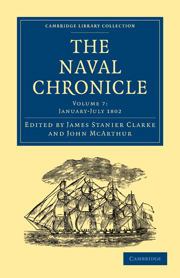 The Naval Chronicle
The Naval Chronicle Book contents
- Frontmatter
- PREFACE TO THE SEVENTH VOLUME
- PLATES IN VOLUME VII. From Original Designs
- BIOGRAPHICAL MEMOIRS OF THE HON. WILLIAM CORNWALLIS, ADMIRAL OF THE BLUE, AND REAR-ADMIRAL OF ENGLAND
- BIOGRAPHICAL MEMOIRS OF THE LATE HON. EDWARD BOSCAWEN, ADMIRAL OF THE BLUE
- BIOGRAPHICAL MEMOIRS OF THE LATE AUGUSTUS LORD VISCOUNT KEPPEL, ADMIRAL OF THE WHITE
- BIOGRAPHICAL MEMOIRS OF RICHARD KEMPENFELT, ESQ. REAR-ADMIRAL OF THE WHITE SQUADRON
- APPENDIX TO THE BIOGRAPHICAL MEMOIRS OF THE LATE LORD VISCOUNT KEPPEL, ADMIRAL OF THE WHITE SQUADRON
- BIOGRAPHICAL MEMOIRS OF THE LATE EDWARD LORD HAWKE, ADMIRAL OF THE WHITE SQUADRON, AND VICE-ADMIRAL OF GREAT BRITAIN
- INDEX
BIOGRAPHICAL MEMOIRS OF RICHARD KEMPENFELT, ESQ. REAR-ADMIRAL OF THE WHITE SQUADRON
Published online by Cambridge University Press: 10 January 2011
- Frontmatter
- PREFACE TO THE SEVENTH VOLUME
- PLATES IN VOLUME VII. From Original Designs
- BIOGRAPHICAL MEMOIRS OF THE HON. WILLIAM CORNWALLIS, ADMIRAL OF THE BLUE, AND REAR-ADMIRAL OF ENGLAND
- BIOGRAPHICAL MEMOIRS OF THE LATE HON. EDWARD BOSCAWEN, ADMIRAL OF THE BLUE
- BIOGRAPHICAL MEMOIRS OF THE LATE AUGUSTUS LORD VISCOUNT KEPPEL, ADMIRAL OF THE WHITE
- BIOGRAPHICAL MEMOIRS OF RICHARD KEMPENFELT, ESQ. REAR-ADMIRAL OF THE WHITE SQUADRON
- APPENDIX TO THE BIOGRAPHICAL MEMOIRS OF THE LATE LORD VISCOUNT KEPPEL, ADMIRAL OF THE WHITE SQUADRON
- BIOGRAPHICAL MEMOIRS OF THE LATE EDWARD LORD HAWKE, ADMIRAL OF THE WHITE SQUADRON, AND VICE-ADMIRAL OF GREAT BRITAIN
- INDEX
Summary
He must not float upon his wat'ry bier
Unwept.—
Milton.Richard Kempenfelt was the son of Colonel Kempenfelt, a native of Sweden, who obtained from Queen Ann a Colonel's commission in the British army. He is said to have been honoured by the friendship of Addison, and to have been the person whose character is so admirably drawn in the Spectator, under the name of Captain Sentry. He died in the reign of George the First, when he was Lieutenant-Governor of the island of Jersey. His son, who is the subject of this narrative, was born at Westminster, in October 1718. He entered the Navy as a Midshipman at ten years old, and got his commission as Lieutenant on the 14th of January 1741. In this rank he continued many years, during which the circumstances of his life are too uninteresting to claim our attention.
In 1756, he was made a Master and Commander; and on the 17th of January 1757, he was appointed to the Elizabeth, of 64 guns, as Captain to Commodore Stevens, who hoisted his broad pendant on board of that ship, on his getting the command of a small squadron destined to the East Indies. This squadron proceeded to its destination soon afterwards, and in the month of April 1758, Kempenfelt signalized himself in a very eminent degree, in the engagement which took place between the English squadron and that of the French under Count D'Achê, and he is mentioned in the Commodore's official dispatch on the occasion, in terms of the highest commendation.
- Type
- Chapter
- Information
- The Naval ChronicleContaining a General and Biographical History of the Royal Navy of the United Kingdom with a Variety of Original Papers on Nautical Subjects, pp. 365 - 388Publisher: Cambridge University PressPrint publication year: 2010First published in: 1802


